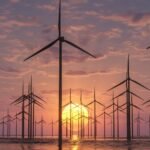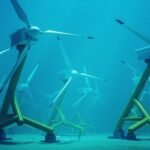Wind energy has emerged as a crucial component of the global shift towards sustainable and renewable energy sources. As concerns about climate change and energy security intensify, wind power offers a viable solution for reducing greenhouse gas emissions and diversifying energy portfolios. This opinion piece explores wind energy’s advantages, environmental impact, technological advancements, economic implications, and future prospects.
Environmental Benefits
One of the most compelling reasons to invest in wind energy is its minimal environmental impact. Unlike fossil fuels, wind power generates electricity without emitting greenhouse gases or other pollutants. Wind turbines do not need water for cooling, making them a sustainable choice in water-scarce regions. Furthermore, wind farms can coexist with agricultural activities, allowing for dual land use. Wind energy significantly contributes to mitigating climate change and promoting environmental sustainability by reducing reliance on fossil fuels.
Technological Advancements
Technological opportunities have played a pivotal role in making wind energy more efficient and cost-effective. Modern wind turbines have advanced materials, aerodynamics, and control systems that maximize energy capture and reduce maintenance costs. Innovations such as offshore wind farms, floating turbines, and vertical-axis turbines are expanding wind energy’s geographical reach and application. These technological strides drive down the levelized cost of electricity (LCOE) from wind, making it competitive with traditional energy sources.
Economic Implications
The economic benefits of wind energy are substantial, particularly in job creation and local economic development. The wind industry provides employment opportunities in manufacturing, installation, maintenance, and research and development. Wind farms also generate revenue for landowners through leasing agreements, contributing to rural economic growth. Additionally, as wind energy costs continue to decrease, consumers can benefit from lower electricity prices. Investment in wind energy infrastructure stimulates economic activity and fosters innovation within the energy sector.
Challenges and Solutions
Despite its numerous advantages, wind energy faces challenges that need addressing. One major concern is wind’s intermittency, which can lead to fluctuations in power supply. Integrating wind power into the grid requires advanced energy storage solutions and management technologies. Furthermore, the impact of wind turbines’ visuals and noise can lead to opposition from local communities. Engaging stakeholders and ensuring transparent decision-making processes are essential for overcoming these social acceptance issues. Ongoing research into more efficient turbines and better storage systems will help address these challenges.
Future Prospects
The future of wind energy looks promising, with continued growth and innovation on the horizon. Government policies and incentives are crucial for supporting the expansion of wind power. International cooperation and investment in research and development will drive further technological advancements. As part of a diversified renewable energy portfolio, wind energy can be central to achieving global sustainability goals. The transition to a low-carbon economy is within reach, and wind energy will be a cornerstone of this transformation.
Conclusion
Wind energy offers a powerful solution to the pressing challenges of climate change and energy security. Its environmental benefits, technological advancements, economic implications, and prospects make it a key player in the transition to renewable energy. While challenges remain, ongoing innovation and supportive policies will ensure that wind energy continues to thrive. Embracing wind power is an environmental imperative and a strategic economic opportunity for a sustainable future.










